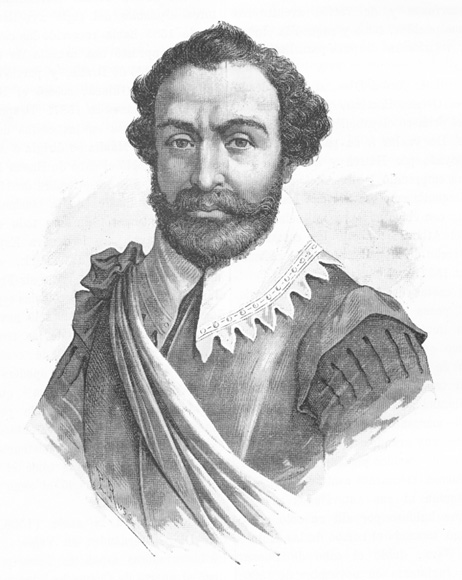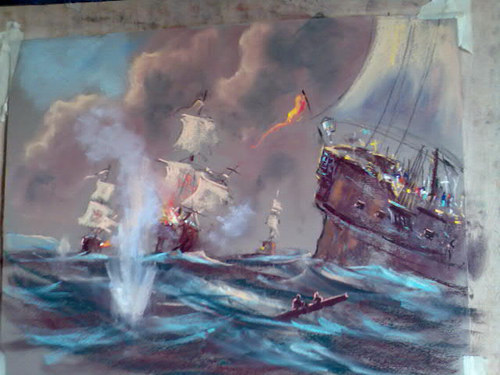--------------------------------------------
--------------------------------------------
 |
| Motherfuckin' Francis Drake. Just wait. |
Or that was the plan.
Robert Burns wrote that the best-laid plans often go awry (well, he wrote 'agley', but he was probably a little bit drunk and definitely very much Scottish), and the Spanish Armada could stand as a gleaming testament to this quote if it had been planned better. The plan was to have the Armada sail the length of the English Channel from the south and escort 30 000 Spanish veterans from where they had been fighting Protestants in the Netherlands, across the Strait of Dover, and invade the shit out of England. What you are about to read is the story of the spectacular failure in this pursuit.
 |
| The Plan: Get better at MS Paint |
England knew that its ships had to beat the Armada. If they didn't, Spain would invade, and on land, wearing armor, and pointing pikes and muskets, there wasn't an army in the West that could go man-for-man with Spain's veterans in the Netherlands. The Royal Navy was the first and only line of defense for the English. Fortunately for England, it was the Royal Fucking Navy.
In charge of the English fleet was a guy named Charles Howard, a politician and cousin to the Queen with impeccable French but no real fighting ability - fans of the Duke of Medina Sidonia will recognize this character type. But, Howard and the English had an ace in the hole. Sir Francis Drake was leading a squadron of ships in the fleet. Drake was a legendary leader of men, a combat veteran, and a seafaring, swashbuckling badass for the ages. I could write about him for hours, but we're here for the Armada, and I digress.
On 20 July, 1588, the Armada was spotted off the southern coast of England, west of Plymouth.The English, stationed at Eddystone Rocks, near Plymouth, were downwind of the Armada, giving the Spanish a sizable advantage. Many ships of this era used rowers, often prisoners, to power the ship forward, but the big gunships like the galleass and galleon did not, and relied solely on their sails for propulsion - and even the galleys, with their oars, still needed a pair of sails to reach cruising speed. As you can see, the wind was a mighty ally in this environment. It was possible to go into the wind using a process called 'tacking', which involved zig-zagging at a snail's pace (highly unfavorable for an entire fleet to do while staying organized), but sailing with the wind was several times faster than tacking, and made maneuvering much easier as well.
So, with the Spanish Armada bearing down, the wind at their backs, an unbeatable opponent, what did the English do? Come charging out of Plymouth Harbour, guns blazing and ready to defend their homeland? Nope. They waited. Cook and Howard famously played a game of bowls (kind of like curling on a lawn) as the Spanish approached. This moment may have been the turning point of the entire expedition. The Duke of Medina Sidonia wouldn't have a better opportunity. Every advantage was his: he had more ships, more men, more guns, better soldiers, and, most importantly, the wind. The Spanish were ready to sweep in and deal a fatal blow to the English while their commanders played a silly English game of lawn bowling.
But they didn't.
Medina Sidonia's lieutenants urged him to attack. They pleaded with him. They would never get a better opportunity to defeat the English. Ship-to-ship, no man believed in the English fleet's chances: the Spanish troops were just too experienced. But here in the Channel, in the open water, at distance, the English still had a puncher's chance, and the Spanish council of war, Miguel de Oquendo and the aforementioned Recalde, wanted to snuff out that threat now - why worry about the fleet at all; crush them now and be done with it.
But the Duke had strict orders. Do not engage unless absolutely necessary. The ships were necessary to transport the lowland troops across at Calais, and they were not to be lost fighting naval battles. The invasion took precedent over pissing contests with Francis Drake on the high seas. So, the Armada sailed on.
The best metaphor for this I can think of is having your opponent grounded in front of you, holding a baseball bat aloft and ready to finish the fight, before suddenly helping him up, handing him the bat, and turning around and facing the other way. By sailing on past Plymouth, the Spanish now placed themselves not just downwind of the English, but facing away from them.
That night, the evening of 20 July, the English began to track the Spanish. The English had begun to enter the field of battle that day, as the Spanish sailed by, on the off-chance that Medina Sidonia changed his mind and attacked. The 50-odd ships split into two groups, one of 11 ships headed by Drake, the rest by Howard. The plan was for Howard to be ready engage while Drake tacked around to gain the weather gage (the upwind position). Now, with the Spanish already passed and the English ships already in the Channel, the chase could begin.
The Armada had amassed themselves in a massive crescent formation, with the elite fighting groups on the tips, while the English approached from the rear in single-line fashion. The Spanish formation was supposed to help protect against broadsides, while the English were set up for speed and maneuverability. Essentially, the Spanish, with their ships brimming with experienced fighting men, wanted the English to have to get close. The English, meanwhile, with their smaller ships and smaller crews, wanted to part of the Spanish close up, and were going to try and fight from afar, using their cannon instead of their swords.
The English ships, in their two squadrons, closed on the powerful ends of the fleeing Spanish crescent, Howard toward the southern tip, Drake to the northern. They came in their single-file formation (dubbed 'line astern'.
On the morning of 21 July, the English closed the distance on the Armada. The view from the English ships must have been utterly cinematic. Ahead of them, fleeing into the rising sun, were bigger, more powerful ships than they had every encountered. A larger fleet had never been assembled in the history of Western Europe. At stake: their Queen, their country, their very religion.
The two lines of English ships managed to catch and surpass the tips of the crescent, and bombard the heavy ships of the line with cannonfire. The agility of the ships, and of the formation, worked brilliantly. The English managed to loose 2000 cannonballs without letting the Spanish return effective fire, or get a single ship close enough to grapple and board.
Unfortunately for the English, hitting a chunk of wood bouncing around in the open ocean with an unrifled shot fired from another frolicking chunk of wood at a quarter-mile distance was really goddamned hard. Of 2000 shots, not a single Spanish ship was sunk due to cannon-fire; though a shitty carrack managed to run into a galleon and become entangled, rendering both useless. After the English receded that evening, after an entire afternoon of battering the Spanish formation, Drake returned to the wrecks and pillaged them for powder and loot. I know, he would, wouldn't he.
Drake's inability to resist Spanish gold was very fortunate for him, as the ships were allegedly loaded for some reason, but proved disastrous for the rest of the English fleet. On the night of 21-22 July, Drake was supposed to lead the fleet with a lantern lit, providing a reference point for the rest of the fleet, so they could stay organized. When he went back to loot the ships, he took the fleet's positional gauge with him, and they fell into disarray. The English had to spend all day on the 22nd just reorganizing the fleet. The Armada trudged on toward Calais and the invasion force.
 |
| I don't know what this is |
English citizens gathered on the hills outside of Portland to witness a confrontation not unlike the one from two days earlier: the English peppered the Armada from a distance, but the Spanish, in their mighty formation, hardly seemed to notice. The wind changed and the Spanish, with a brief advantage, sought to close, but to no avail. The English ships were too nimble. The day was a wash - in fact, since the Spanish managed not to run into each other, this battle was even less significant than the previous one, as no damage was done on either side.
At this point, the Armada's trip seemed to be nearing its end. The English fleet had been unable to do too much more than pester them, and had certainly not displayed enough punching power to stop them. Everything was going well enough - but there was a hitch. They were less than 200 miles (about 300 km) from Calais, and the Duke of Medina Sidonia had not yet heard from the Duke of Parma, in charge of the Spanish veterans in the Netherlands. The Armada was closing on its target - but it had no idea if the army would be ready for transport.
As the Armada approached the Isle of Wight, the Duke of Medina Sidonia faced an enormous decision: station here and wait for word that the army was ready, or press on and hope that it was. You see, once past the Isle, there were no natural harbors for the Armada, and they would be stuck out on the open sea. There wasn't even anywhere to drop anchor on the Spanish-controlled coastlines of Flanders. Once past the Isle of Wight, it was Calais or bust.
Medina Sidonia, showing again his aversion to any sort of risk, decided to anchor in the Solent, the body of water between the mainland and the Isle. He tried to steer Armada around the Isle to the south, then turn north into the Solent. The British were two steps ahead:
 |
| Holy shit I'm bad at this |
But then came Drake. Charging fast from the open sea, Drake pounced ferociously on the southern tip of the Spanish crescent. Fearing that his galleons were in serious danger to the English marauder, Medina Sidonia pulled the weight of his fighting ships in the center of the line south to deal with Drake. This was a mistake. Because the Spanish were busy rearranging their formation, there was something they weren't doing - entering the Solent. Instead, they headed for peril.
You'll see on my awesome map the black lines marked 'Owers.' These are the Owers sandbanks, one of the most treacherous landmarks of the Channel. Shortly after he dispatched reinforcements to the southern tip, Medina Sidonia realized his folly - he was headed straight for the Owers. In order to avoid running aground, and to keep the Armada together, he called a full retreat back to the open sea. The Armada would not be anchoring in the Solent, and though they had once again failed to sink any Spanish ships with their guns, Howard and Drake had succeeded in preventing the Spanish from setting foot on English soil.
And so, for the Spanish, the English, the Spanish troops in Holland, and for you, the reader, it was off to Calais for the final chapter in this tale. In Part Five we will view how this all shakes out, both the final leg of the Armada's journey, and some behind-the-scenes stuff that just might explain the folly of it all.

No comments:
Post a Comment